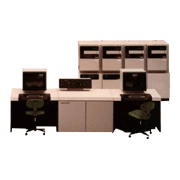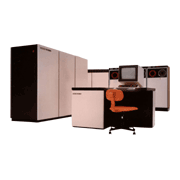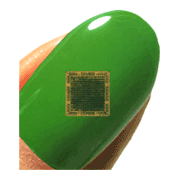The HITAC M-200 Series was a general-purpose machine developed as the successor of the early models of the M Series (such as the M-180, M-170) with the aim to achieving an improved performance/cost ratio, and incorporating the latest features.
The high-end models, the M-280H and M-260H, were based on technology developed for the M-200H, and they achieved higher levels of performance and functionality by using newly developed technology, such as world leading logic-in-memory, 4Kbit/7ns high-speed bipolar memory, 550/1500gate LSI and platters which increased the degree of integration to 18 levels. Due to their outstanding cost-performance, these models were exported in large numbers to Europe and the US, where they enjoyed an outstanding reputation. For scientific and engineering calculations, the M-280H was equipped with high-speed arithmetic mechanisms and a built-in array processor.
The M-280H had 3.5 to four times the processing power of the M-180. The M-280D, which had about one-third the processing power of the M-280H, was field upgradable to an M-280H machine. The M-260H had 3.5 to four times the processing power of the M-170. The M-260K had about 1.3 times the processing power of the M-260H, and the M-260D had about one-fourth the processing power of the M-260H. The M-260D was field upgradeable to either the M-260H or the M-260K, and the M-260H was field upgradeable to an M-260K machine. Hitachi added the lower-end models M-240D, M-240H, M-220D, M-220H, and M-220K, forming a new family under the M series. The M-220D, M-220H, and M-220K processor group was field upgradeable to more powerful models at the installation site.
| M-220D | M-220H | M-220K | |
|---|---|---|---|
| No. of CPUs | 1 | 1 | 1 |
| Main memory capacity | 1 to 8 MB | 1 to 8 MB | 2 to 8 MB |
| Buffer size | − | − | − |
| No. of channels | 3 to 5 | 3 to 5 | 3 to 8 |
| Announcement date | March 1983 | June 1982 | March 1983 |
| M-240D | M-240H | |
|---|---|---|
| No. of CPUs | 1 | 1 |
| Main memory capacity | 2 to 16 MB | 2 to 16 MB |
| Buffer size | 64KB | 64KB |
| No. of channels | 3 to 8 | 5 to 8 |
| Announcement date | March 1983 | June 1982 |
| M-260D | M-260H | M-260K | |
|---|---|---|---|
| No. of CPUs | 1 | 1 | 1 |
| Main memory capacity | 8 to 32 MB | 8 to 32 MB | 8 to 32 MB |
| Buffer size | 32KB | 64KB | 64KB |
| No. of channels | 8 to 32 | 8 to 32 | 8 to 32 |
| Announcement date | February 1983 | October 1981 | February 1983 |
| M-280D | M-280H | |
|---|---|---|
| No. of CPUs | 1-4 | 1-4 |
| Main memory capacity | 16-64MB | 16-64MB |
| Buffer size | 64KB | 256KB |
| No. of channels | 8 to 32 | 8 to 32 |
| Announcement date | February 1983 | February 1981 |
The M-220X models, successors to the M-220H, were developed as computer systems to provide integrated office automation systems for the new media age. The four models — M-220DX, M-220HX, M-220KX, and M-220LX — were field upgradeable to more powerful machines at the installation site.
This family offered improved reliability, a smaller footprint, and less power consumption due to the extensive use of LSI chips, including high-speed 1,500-gate LSI chips for the main logic circuits, CMOS gate-array LSI chips with 24,000-gates per chip that provided the peripheral control circuits with much faster speeds and dramatically less power consumption, and 256-kilobit DRAM chips for the main working memory. Space was also saved because a dedicated console was not needed.
| M-220DX | M-220HX | M-220KX | M-220LX | |
|---|---|---|---|---|
| No. of CPUs | 1 | |||
| Main memory capacity | 4 to 16 MB | 8 to 16 MB | ||
| Maximum no. of channels | 8 | |||
| Channel throughput | 8MB/s | 10MB/s | 12MB/s | |
| Announcement date | October 1985 | |||






